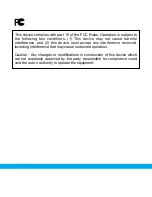
/ BROADCAST SOLUTIONS
www.SymetrixAudio.com
Connection and MIDI Channel
Connections
After installing the 6200 in its permanent position, you may connect
the RC-1. Position the RC-1 Remote Control in a convenient, but secure
location. Route the 25-foot cable between the two devices. Secure the
cable so that it is not a tripping hazard or located where it could be
damaged by moving equipment or furniture. Good news! Both ends
of the cable are male; you can’t install it backwards.
The RC-1 connects to the 6200 with the included 25-foot, 7-pin DIN
cable. The 6200 and RC-1 exchange MIDI information on pins #2 and
#3. The 6200 provides power for the RC-1 on pins #1 and #7. Pin #7
is +V; pin #1 is ground. To preserve compatibility with other MIDI
devices, the remaining pins on the connector are not used. If you con-
nect the 6200 to a MIDI controller other than the RC-1, make sure you
use a cable which does not have Pin #7 connected.
Caution:
The RC-1 includes a jack for an optional 9 VDC power supply
providing at least 30 mA (not supplied). If you use the RC-1 with the
6200 and the supplied 7-pin DIN cable, the RC-1 takes its power from
the 6200. No external power supply is required when using the RC-1
with the 6200 and the provided cable. The optional 9 VDC connection
allows you to use the RC-1 with other MIDI controlled devices which
to not supply power. NOTE: Symetrix does not make, sell or recom-
mend a power supply.
You will notice that none of the LEDs on the RC-1 are lighted when
it is first plugged in. This is normal; the LEDs serve as tally lights
indicating which button was pushed last. The LEDs do not provide
positive confirmation from the 6200 that the program selected was
loaded by the 6200. The RC-1 will not reflect a change in program
selection made at the front panel of the 6200. The LEDs on the RC-1
serve as reminders of which button on the RC-1 the user pressed last.
(MIDI communication is one-way, from RC-1 to 6200.)
MIDI Channel
The RC-1 comes from the factory configured for MIDI channel #1. You
may change the MIDI channel identification of the RC-1 by the use of
four solder jumpers on the bottom of the RC-1 circuit board. The table
on the following page identifies the jumpers which must be bridged
with solder to identify the RC-1 for each possible MIDI channel. The
“X” indicates a jumper requiring solder closure. Do not solder across
the jumpers marked “0”. Please note that J4 is on the left and J1 is on
the right (just as in the table).
To change your RC-1’s MIDI identification, disconnect all
connectors from the RC-1. Remove the chassis bottom by taking out
the screws in both sides of the RC-1. Lift the bottom cover off. Locate
J1, J2, J3 and J4 in the rear center of the circuit board. Solder together
the jumpers marked with an “X” in the table which correspond with
the desired MIDI channel identification. Replace the bottom cover
and retaining screws.
MIDI
Channel
J4
J3
J2
J1
1
0
0
0
0
2
0
0
0
X
3
0
0
X
0
4
0
0
X
X
5
0
X
0
0
6
0
X
0
X
7
0
X
X
0
8
0
X
X
X
9
X
0
0
0
10
X
0
0
X
11
X
0
X
0
12
X
0
X
X
13
X
X
0
0
14
X
X
0
X
15
X
X
X
0
16
X
X
X
X
3
Page
AIRTOOLS RC-1
AIRTOOLS 6200


























